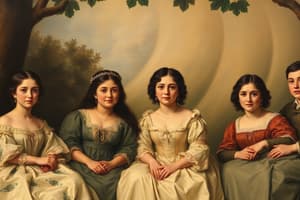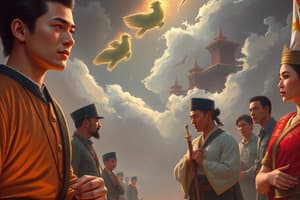Podcast
Questions and Answers
Who wrote the memoirs titled 'The Katipunan and the Revolution: Memoirs of a General'?
Who wrote the memoirs titled 'The Katipunan and the Revolution: Memoirs of a General'?
- Alvarez (correct)
- Bonifacio
- Agoncillo
- Mabini
What was the role of Mabini during the Philippine Revolution?
What was the role of Mabini during the Philippine Revolution?
- Diplomatic Envoy
- Historical Chronicler
- Military Commander
- Legal Adviser (correct)
Which source type is considered a non-written source?
Which source type is considered a non-written source?
- Official Documents
- Court Records
- Artifacts (correct)
- Letters
Who was the Spanish friar of the Franciscan Order mentioned in the context?
Who was the Spanish friar of the Franciscan Order mentioned in the context?
Which individual is known for losing the use of both legs to polio before the revolution?
Which individual is known for losing the use of both legs to polio before the revolution?
What is the total number of persons who signed the Philippine Declaration of Independence?
What is the total number of persons who signed the Philippine Declaration of Independence?
The Declaration of Independence in the Philippines took place in which location?
The Declaration of Independence in the Philippines took place in which location?
In what year did the factions of the Katipunan convene at the friar estate administration building?
In what year did the factions of the Katipunan convene at the friar estate administration building?
Who is recognized as the first and youngest President of the Philippines?
Who is recognized as the first and youngest President of the Philippines?
What does the term 'Aliping namamahay' refer to?
What does the term 'Aliping namamahay' refer to?
What was the purpose of the 'Kartilya'?
What was the purpose of the 'Kartilya'?
Who wrote the memoir 'The Philippine Revolution' and who translated it into English?
Who wrote the memoir 'The Philippine Revolution' and who translated it into English?
What is the meaning of the Greek word 'istoia'?
What is the meaning of the Greek word 'istoia'?
Which faction was formed on April 2, 1896?
Which faction was formed on April 2, 1896?
Who is considered the 'Brains of the Philippine Revolution'?
Who is considered the 'Brains of the Philippine Revolution'?
What is the primary focus of Oral History?
What is the primary focus of Oral History?
Flashcards are hidden until you start studying
Study Notes
Key Figures in Filipino History
- Agoncillo: Prominent Filipino historian known for advocating a nationalist perspective in history.
- Pigafetta: Italian explorer and scholar from Venice, documented the first voyage around the world.
- Plasencia: Spanish Franciscan friar and author of "Customs of the Tagalogs."
- Mabini: Filipino revolutionary leader, lawyer, and educator, paralyzed by polio before the revolution.
- Aguinaldo: First and youngest President of the Philippines.
Important Events and Milestones
- Philippine Declaration of Independence took place in Kawit, with 98 signatories.
- The Magdiwang faction was established on April 2, 1896, under Alvarez's orders.
- The meeting of rival factions Magdiwang and Magdalo occurred on March 22, 1897.
- Rizal was executed in Bagumbayan on December 30, 1896.
Historical Sources and Methods
- History: Study of human affairs and past events; not everything is known.
- Primary Sources include artifacts, court records, memoirs, and testimonies.
- Historical Method involves critically examining historical records and oral histories.
- Internal Criticism tests the credibility of sources, focusing on reliability.
- External Criticism addresses the authenticity of documents.
Notable Literary Contributions
- "Doctrina Cristiana": First book printed in the Philippines.
- "The Katipunan and the Revolution: Memoirs of a General": Written by Alvarez, published in 36 installments.
- "The Philippine Revolution": Memoirs by Mabini, translated by Leon Ma. Guerrero.
Important Concepts
- Geschite: German term meaning “that which has happened,” equivalent to history.
- Aliping namamahay refers to commoners in the historical context.
- Kartilya: A guidebook for KKK members, first written by Bonifacio.
Historical Contributions and Analysis
- Fox: Anthropologist and historian specializing in pre-Hispanic Philippines.
- Scott: Historian focused on the Gran Cordillera Central and pre-Hispanic Philippines.
- The total goal of historians is to reconstruct mankind's past, though it's unattainable.
Community and Commands
- Cavite province was overtaken by General Polavieja's forces.
- Don Baldomero Aguinaldo led the Magdalo faction, which included several towns in Cavite.
- Ricarte was in command of citizens in Noveleta, Cavite.
Miscellaneous
- Tagalog literature reflects cultural practices and societal structure.
- The year 1492 marks the birth of Pigafetta, instrumental in chronicling early Filipino interactions with Europeans.
Studying That Suits You
Use AI to generate personalized quizzes and flashcards to suit your learning preferences.




